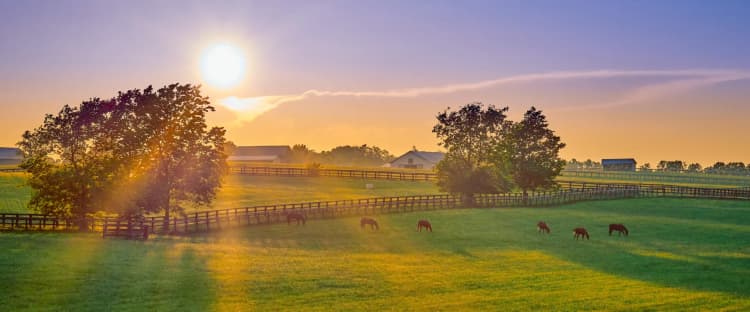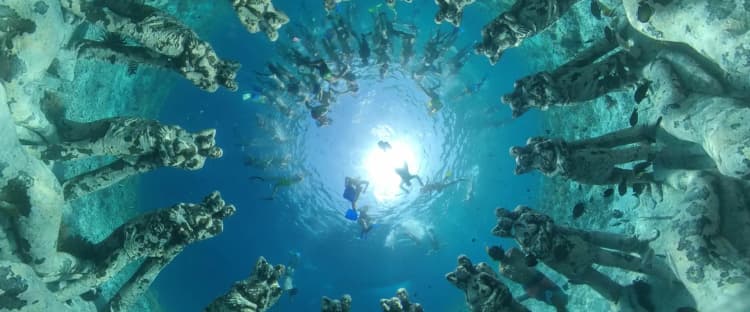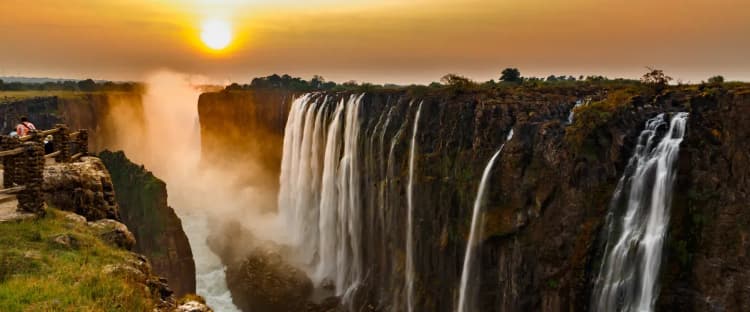
Montréal: The French-Canadian City Where Art is Everywhere
A sprawling, cosmopolitan city on an island, Montréal is the cultural heart and soul of the province of Québec. Vibrant and eclectic, it’s home to about 1.7 million people (making it the second-most populous city in Canada), and a go-to destination for history buffs, architecture lovers, foodies, fashionistas, artists, and athletes.
Similar to other cities its size, Montréal’s history is filled with scandals and intrigue, but the city continues to grow and evolve. Its restaurants and arts programs are internationally known, and with Montréal’s focus on creating a better quality of life through urban planning and design, it’s on track to becoming Canada’s top destination.
Indigenous roots
Montréal (known as Tiohti:áke in Kanien'kéha) resides on unceded Indigenous land belonging to the Kanien’kehá:ka Nation. While it’s believed first contact was made by the Dutch, followed by Jacques Cartier in 1535-36, it was 1642 before the French got their way and started the settlement we now know as Montréal.
In the early days, schools were established by the church to teach the Indigenous children, a way to assimilate them into French culture. By 1883 a federal system of residential schools was established and schools popped up all over Canada. The deculturalization, neglect, and abuses inflicted were horrifying (in June 2021 a mass grave was discovered at a former residential school in British Columbia, which has helped bring wider attention to these atrocities).
Today, Montréal’s McCord Museum has a permanent exhibit, “Indigenous Voices of Today: Knowledge, Trauma, Resilience,” which is a good place to start a self-guided decolonization tour of Montréal, while the movie, Indian Horse, provides a glimpse of the abuses suffered in the schools.
Each August the First Peoples’ Festival, spearheaded by the LAND InSIGHTS organization, brings together Indigenous artists from throughout the Americas. And all year round, Indigenous cuisine can be enjoyed at the Mikmaq Catering Indigenous Kitchen, headed by Chef Norma Condo.
City of murals

Boulevard Saint-Laurent (the Main) in Montréal's Le Plateau-Mont-Royal neighborhood is the epicenter of the city’s street art scene. This is where graffiti, as an art form, took root in the mid-90s.
Murals have become an integral part of Montréal’s identity, with over 3,500 located throughout the city. A few publicly funded initiatives have been created to promote its growth, MU being the most well-known. The city also celebrates street art with dedicated festivals like Under Pressure, the oldest urban cultural festival in North America, and MURAL, a three-day festival focusing on democratizing street art.
Begin an exploration of Montréal’s murals with a walking tour along the Main, then branch out and discover works by Montréal artists such as Chris Dyer, Kevin Ledo, Tristan Eaton, and Ola Volo. Go to Notre-Dame-de-Grâce (nicknamed NDG and located on Madison and rue Sherbrooke Ouest) to see the five-story “Our Lady of Grace” by Alphonse Mucha, and check out “Dazzle My Heart” by Michelle Hoogveld, a gorgeous mural covering the façade of Hôtel Le Germain.
Reckoning with a dark past
Old Montréal’s cobblestoned streets are lined with 18th- and 19th-century buildings, pieces of living history that bewitch thousands of visitors each year. Here, you’ll find antique shops, boutique hotels, restaurants, art galleries, and boutiques both kitschy and trendy. It’s an enchanting way to begin your exploration of the city, but this beautiful part of the city has an ugly past.
This is where the city began in 1642, then known as Ville-Marie. The growth of the colony was slow due to labor shortages, and in 1689 King Louis XIV allowed enslaved people to be brought from the West Indies and Africa. Over time enslaved people arrived from Europe and the American colonies as well. Soon, Montréal was home to the largest population of enslaved Black people in New France.
In 1734 a fire ravaged the merchant area, destroying 46 buildings, including the hospital. Marie-Joseph Angélique, an enslaved Black woman, was accused, tried, tortured, hanged, and burned for the crime. A square near City Hall is now known as the Place Marie-Josèphe-Angélique and it’s one of the spots visited on a walking tour of Old Montréal’s Black history.
Montréal’s darling musician

In the Golden Square Mile neighborhood, a portrait mural of Leonard Cohen towers over rue Crescent. Created by Montréaler Gene Pendon and American El Mac, the mural is 21-stories tall—a perfect tribute to Cohen, whose music, laced with a sadness that grips the soul, continues to comfort us.
One of Montréal’s most beloved musicians, Cohen was a novelist prior to becoming the singer and songwriter we know and love. Cohen spent a great deal of time on the Greek island of Hydra, where he met his lover and muse, Norwegian-born Marianne Ihlen. Netflix has released a documentary, Marianne & Leonard: Words of Love, which explores the power of their relationship.
He returned to Montréal in 1957, and by the 1970s he was an international star. Cohen bought a duplex in Le Plateau-Mont-Royal and was often seen going to Parc du Portugal, the Main Deli Steak House, and Bagel Etc. His song, Suzanne, speaks of Suzanne Verdal, the free-spirited wife of an artist friend who lived by the Saint-Lawrence River and served him tea and oranges.
There’s probably a festival for that!
From the early days of the colony to today, Montréalers have gathered to celebrate through food, music, art, literature, and sport. Festivals and events fill Montréal’s annual calendar, thanks in part to its high concentration of post-secondary students (Montréal has four universities and 3 colleges), and international communities.
Montréal Jazz Festival, Osheaga, Igloofest, POP, MUTEK, and Les Francos de Montréal are among several music festivals. In summer, the world-famous Just For Laughs comedy festival is a side-splitting good time.
In film, the Montréal International Black Film Festival, Cinemania, and Fantasia are among the best. Nuit Blanche à Montréal in February kicks off the culture and arts-based festivals, followed by Lumière, Festival Nuits d’Afrique, Pride, and Fashion Forward. Foodies will enjoy MTLàTABLE, Poutine Week, and YUL EAT.
UNESCO City of Design

In 2006, Montréal was designated a UNESCO City of Design. In the application to the committee, Montréal mayor Gerald Tremblay stated, “Design in Montréal is not simply for show but a source of daily well-being, and it is becoming a basic value for Montréalers.”
The city’s focus on design includes landscape architecture, urban architecture, interior, industrial, graphic, fashion, gastronomy, literature, music, media arts, crafts, and folk arts. While the main focus is the quality of life of its residents, visitors to Montréal benefit greatly to this initiative as well.
Montréal is home to more than 39 museums, 27 theaters (serving both the French and English communities), and hundreds of statues, murals, restaurants, bars and cafés throughout the city. Festivals and events centering around the arts, food, sports, and the various cultures which call Montréal home take place every month of the year.
Jewish Montréal
After the British conquered Québec (New France) in 1759, the British army brought merchants and traders to Québec, many of whom were Jewish. In Montréal, the new immigrants settled into the area we now know as the Golden Square Mile. When the next wave of Jewish immigrants arrived in the 1880s, they spoke Yiddish and settled along boulevard Saint-Laurent (The Main).
Montréal’s Hasidic community began in the 1920s, centered in the area now known as Outremont, and after World War II Holocaust survivors began arriving in the city. Unlike previous waves, the survivors faced discrimination from all sides, including previously established Jewish communities. The Montréal Shtetl: Making Home After the Holocaust by Zelda Abramson outlines some of the struggles faced by survivors arriving in Montréal.
The Museum of Jewish Montréal chronicles Jewish culture and history through art, oral histories, and tours that delve into foodstuffs, famous poets, public and religious figures, and local stories. Montréal bagels and smoked meat are among the more famous Jewish foods, but to focus solely on those would be a disservice to your taste buds. Schwartz’s, Lester’s, Hof Kelsten, Cheskie’s, Wilensky’s, Arthurs, and Beautys are a few places to stop for a nosh.
Bagels, poutine, smoked meat, and more

When it comes to famous Montréal foods, the bagel hovers around the top of the list. Boiled in honey water and baked in wood-fired ovens, Montréal bagels are dense with holes so large you could wear them as a bracelet.
It’s believed that Chaim (Hyman) Seligman sold the first bagels from a cart in 1900, and that the first bagel shop was Montréal Bagel Bakery, which opened in 1919. The shop was operated by Isadore Shlafman and Jacob Drapkin, but they fell out and Shlafman founded Fairmount Bagels in 1949. In the early ‘50s, Myer Lewkowicz began working for Seligman, but in 1953 Lewkowicz left and founded St-Viateur. Now St-Viateur and Fairmount are the two most iconic shops, producing hundreds of bagels every day.
Fairmount, however, holds the distinction of being the only bagel that’s gone to space after Astronaut Gregory Chamitoff (nephew of Fairmount’s current owner) took some with him to the International Space Station.
Schwartz’s Deli is most famous for serving smoked meat sandwiches—kosher beef brisket which is salt-cured and spiced, rested for at least a week and then hot smoked—but skip the crush of people and dive into this classic Montréal sandwich at Lester’s Deli, Snowdon Deli, or the Main Deli Steakhouse.
Orange Julep is a massive orange sphere (picture a 40-foot wide and three-story tall roadside orange and you’ve got it) serving up orange juice milkshakes, and a must on hot summer days. Instead of going to Poutine La Banquise, enjoy poutine (fries topped with squeaky cheese curds and a hot beef and chicken gravy) at Greenspot or Chez Tousignant. It is a gooey treat and a favorite hangover food. Devour tasty Italian sandwiches at BOSSA in Verdun; it’s worth the trip to this far-flung neighborhood.
The last Chinatown in Québec
Montréal is home to the only remaining Chinatown in Québec. Chinese immigrants began arriving in Montréal in the 1890s, many of whom had been working in mines and building railroads in Western Canada. Chinatown began with small shops and laundries on rue de la Gauchetière, and became a tourist attraction after Expo 67. Between 1979 and 1982 around 16,000 Vietnamese, Cambodian, and Laotian refugees arrived in Montréal.
The Wing Building on rue de la Gauchetière (built in 1826) is home to Wing Hing Lung, manufacturer of the first bilingual fortune cookies. Restaurant ChinaTown KimFung is a go-to for dim sum, while Nouilles de Lan Zhou is known for slurp-tastic hand-pulled noodles.
Chinatown is also an important center for specialty Asian grocery shops, Parc Sun Yat-Sen, a Buddhist temple, and a community center—but it’s under threat of disappearing as land developers move in, buying up buildings, and pushing residents and businesses out.
From the mountains to the beach

Triple-peaked Mont Royal stands guard over Montréal, offering up sweeping views of the city. Roughly 500 acres of green space, it was named Parc Mont-Royal in 1876. In summer and autumn, the park is perfect for hiking, cycling, outdoor concerts, and picnics. In winter, it’s a go-to destination for tubing, snowshoeing, skating, and skiing. The Lachine Canal is a favorite with locals who enjoy quiet walks in the city, beautiful any time of year.
On hot sticky summer days, Montréal’s beaches are a welcome refuge, and every beach has its own vibe. An island with about 165 miles of shoreline, Montréal has over 15 beaches. Verdun Beach is a popular spot for families, and small dance parties often break out in the evenings. Clock Tower Beach in Old Port, a short walk from Old Montréal, is a fun spot to relax on a beach chair underneath a parasol. Pointe-Calumet Beach is a constant party with drinking, dancing, and over-the-top volleyball.
The underground city
Montréal is one of the coldest cities in North America. Winter starts out mild, but by January temperatures can drop into the -20s Fahrenheit with the windchill. Combine that with an onslaught of snow, ice, and Montréal’s hills, and walking around outside can be one unexpected adventure after another.
Thankfully, Montréal has an underground city, called RÉSO, a pedestrian-only network of around 20 miles of shopping malls, movie theaters, shops featuring locally made products, entrances to museums, restaurants, and the Le Cathcart food hall. In winter, almost 500,000 people use the underground daily to escape Montréal’s bitter cold.
Join Going to get cheap flights to Montréal and around the world.
More Canadian destinations
Published October 26, 2023
Last updated December 19, 2023
Articles you might like
View AllTreat your travel to cheap flights
Most deals are 40-90% off normal prices with great itineraries from the best airlines. If it's not an amazing deal, we won't send it. Sign up for free to start getting flight alerts.




